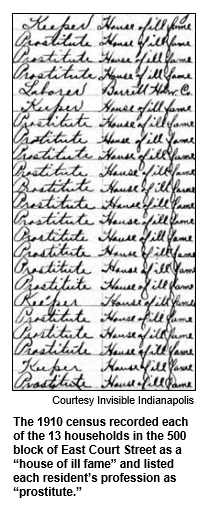May 24, 2019
(May 18, 2019) In our quest to explore all aspects of our heritage, even the unsavory and notorious, this edition of Hoosier History Live delves into a seldom-examined topic: Red-light districts and prostitutes in Indianapolis at the turn of the last century.
To examine these aspects of the Hoosier state capital's social history, Nelson's studio guest on this encore show (originally broadcast July 8, 2017) is Paul Mullins, a popular professor in IUPUI's Department of Anthropology.
A historical archaeologist, Paul has researched and written about pre-1920 prostitution as part of a larger project titled "Invisible Indianapolis: Race, Memory, and Community Memory in the Circle City."
Along with co-director Susan Hyatt and a team that includes both undergraduate and graduate students, Paul has published the project's findings in a blog called Invisible Indianapolis.
The project's overarching goal: to show the historical impact of seemingly invisible urban social factors such as racial redlining, highway construction and gentrification.

- An area bounded by what is today Park Avenue (then called Liberty Street) and Market, East and Washington Streets.
- A district at the site of what is now another hospitality building, the Indiana Convention Center. The district ran along Senate Avenue near Georgia Street.
"Prostitution probably always was an element of the early cityscape, but some of the earliest evidence for houses of prostitution comes in the 1850s," Paul writes in the blog.
He quotes an 1857 newspaper account of a shooting at a brothel managed by a "mysterious woman." After the shooting, he adds, the illicit business "became the target of mob justice when [the woman's] brothel was set afire by a mob of more than 200 people."

"The desperation of some women working as prostitutes was documented in a string of suicides and suicide attempts," Paul reports.
Paul Mullins is a past president of the Society for Historical Archaeology. For several years, Paul and his students could be seen during the summer months excavating sites near the IUPUI campus. Paul was a Hoosier History Live guest in 2009 when he was leading an excavation on the site of the long-demolished home of Madam Walker, the wealthy African-American entrepreneur and philanthropist.
According to Paul's research for Invisible Indianapolis, prostitutes often worked "in and around" Union Station during the late 1800s and early 1900s. (Before majestic Union Station opened during the 1880s, its predecessor, Union Depot, was the first train station in the country where competing railroad lines came together.)
Near the bustling train station, brothels were located among saloons and stores on South Street.
Farther east, a bygone street named East Court Street (now a parking lot between East and Park) had a cluster of brothels that Paul describes as "the city's most prominent concentration" of such businesses. In 1898, a Sanborn map "identified nearly every structure on East Court as a 'female boarding house,'" Paul writes, noting that at least 10 of these 16 homes listed in the 1899 city directory were brothels.
His blog describes attempts by local churches to encourage police raids of the brothels. Some of the churches also were active in the temperance movement.